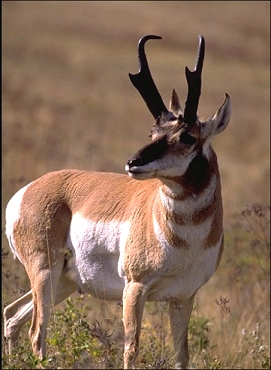

What can outrun a roadrunner, spot trouble 4 miles away, and shed its horns? What else but a Pronghorn, one of the visions of beauty we sometimes see dashing across the desert floor. Its scientific name, Antilocapra americana, literally means "American antelope goat", but despite the name, it's related to neither of these animals. It is unique as the only surviving member of the ancient family, Antilocapridae, which goes back 20 million years.
This majestic animal can run up to 60 miles per hour, leaping across
the desert floor in 20-foot bounds. Unlike the world-renowned cheetah, pronghorns can
maintain a fast pace for hours. When they spot danger, they flash their white rump
patches, warning other pronghorns up to 2 miles away. The young are born in May or June
and weigh about as much as a newborn human. Though vulnerable to predators as small as
bobcats and eagles, they are masters of camouflage. Within 2 days, the tiny fawns can
run 25 miles an hour. Those who survive their first 2 months may live 10 years, gracing
our desert with their presence.

Listen to the Audio (mp3 format) as recorded by KTEP, Public Radio for the Southwest.
Contributor: Kodi R. Jeffery, Centennial Museum, University of Texas at El Paso.
Desert Diary is a joint production of the Centennial Museum and KTEP National Public Radio at the University of Texas at El Paso.

Male Pronghorn (Antilocapra americana). Photographer: Gerald and Buff Corsi. z© 1999 California Academy of Sciences.